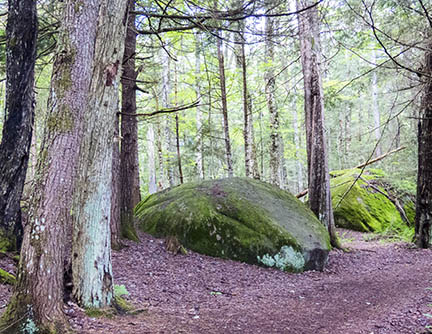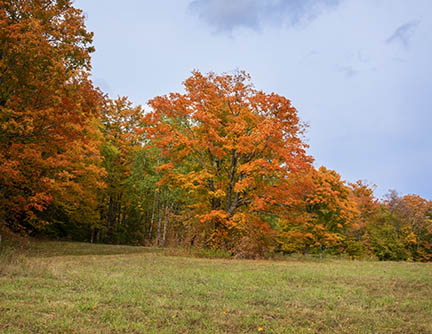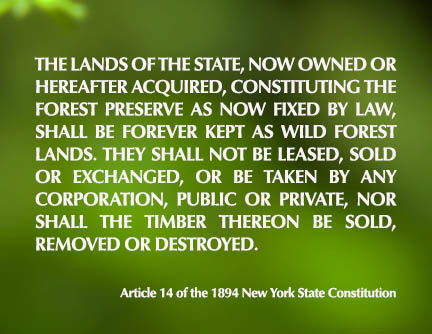Explore the Adirondack Mountains

The six-million acre Adirondack Park in upstate New York is probably the most accessible place to explore nature in the northeastern US. The Park's many nature trails and backcountry hiking trails offer opportunities to learn about the habitats, wildlife, and plants of the Adirondack Mountains. The landscape we see as we gaze out over lake, pond, river, wetland, or forest is a fleeting snapshot of a changing environment.
- The rocks which comprise the Adirondacks are very old; but the mountains themselves are young and are continuing to rise, at an estimated rate of about 3 millimeters a year.
- The forests themselves are constantly changing. The landscape is a patchwork of virgin forest, second-growth forest, successional fields, and agricultural land. Only about 10% of the Adirondack Park is undisturbed forest – the part of the Adirondacks that has escaped logging, development, blowdown, ice storm, or fire. Much of the rest is in various stages of recovery from those disturbances, and may be seen as recovering wilderness. Climate change, together with other forces such as acid rain and residential development, is shaping that recovery, favoring some species and disadvantaging others.
- The plants and animals which make their homes in these diverse ecosystems are also in a constant state of flux. Some boreal bird species, apparently responding to a loss of habitat, are in decline. Other birds more common in downstate New York are now making their way north into the Adirondacks.
Shaping the Landscape: The Geology of the Adirondacks

The geologic history of the Adirondacks has two major chapters: the doming of the Adirondacks which created the mountain range, and the subsequent sculpting of those mountains by glaciers during the Pleistocene epoch (Ice Age).
- The shaping of the Adirondacks was part of a larger process involving the movement of the earth's tectonic plates. The story is a complex one, beginning over a billion years ago and involving the coming together and breaking up of continents and the appearance and later closing of ancient oceans. The Adirondacks – the product of this lengthy process – are a unique mountain range. They are not part of the Catskills or Appalachian Mountains. They are new mountains, although made of old rocks, and are still growing, faster than erosion is wearing the surface away.
- The second series of events to shape the Adirondack landscape began much more recently, about 1.6 million years ago, when cooling climates around the world led to the repeated advance and retreat of huge ice sheets in the northern hemisphere. This era is known as the Pleistocene Epoch or (more popularly) the Ice Age. The Adirondacks' glacial past is evident in wide range of topographic features and glacial landforms, including glacial erratics, eskers and kames, cirques and aretes, and kettle ponds.
Adirondack Wilderness

After the glaciers that sculpted the Adirondacks retreated some 13,000 years ago, glacial ice was replaced by tundra, then by boreal forests. These boreal forests were later replaced by a mix of boreal and temperate forests that comprised the Adirondack wilderness of the early 17th century, when European settlers arrived in the New World. A harsh climate and poor soil had discouraged the Native Americans who occupied the valleys around the mountains from permanent residence in the mountains and initially inhibited exploitation by the European newcomers.
In time, however, the Adirondack wilderness that greeted European settlers succumbed to economic pressures that were reshaping the landscape throughout North America. The wilderness we see today is not the original, post-glacial wilderness, but a recovering wilderness, thanks to policies designed to rescue the wilderness from the ravages of exploitation. Natural forces are gradually repairing the initial man-made scars of logging, mining, and farming; however, this process is shaped by ongoing human impacts, including development, acid rain, and climate change.
Forever Wild: The Adirondack Park

The region's escape from the agrarian and urban development that largely surrounds it is due to a combination of factors.
- The harsh climate and shallow soil meant that the region was spared the influx of settlers who moved into more fertile lands in the 18th and early 19th centuries.
- The other major factor was the formation of the Adirondack Park in 1892, combined with the adoption (in 1894) of a proviso in the New York State Constitution that the Forest Preserve lands "shall be forever kept as wild forest lands." There were two drivers behind the decision to preserve the Adirondack forest: the spiritual position that experiencing untrammeled nature in the wild Adirondack Mountains was restorative and the utilitarian position that maintaining healthy Adirondack forests was vital to transportation and agriculture in the rest of the state.
- Emerging threats to the landscape in the 20th century, in particular development and increased tourism, led eventually to the creation in 1971 of the Adirondack Park Agency (APA). Its actions have pleased neither conservationists who bemoan its inadequate protection of the Adirondacks' natural resources nor business interests and locals who resent its efforts to restrict their activities.
The Park which has emerged from these developments is the largest publicly-protected area in the contiguous United States, encompassing about six million acres. It is a mixture of publicly-owned and private land. The Park has over 3,000 lakes, 30,000 miles of rivers and streams, 42 peaks over 4,000 feet, and a wide variety of habitats, including globally unique wetland types and old growth forests. Although no areas of the Adirondack Park have completely escaped the impact of human activities, for many people in the northeast, the Adirondack Park is the most accessible way to experience "wilderness," in the sense of exploring and enjoying a relatively unspoiled natural habitat.
